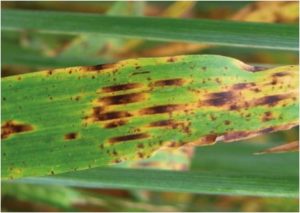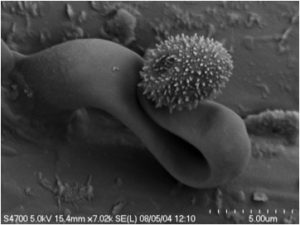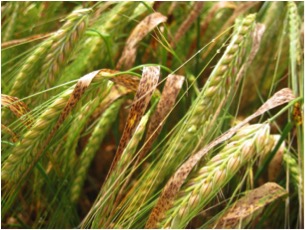Ramularia update
22 January 2018
Identification is tricky as barley gets lots of spots but the classic 4 ‘R’s of ramularia ID are rectangular spots (bounded by the veins), ring of yellowing (as the disease draws nutrients in to itself), reddish in colour and right through the leaf (sun scorch and physiological spots are usually just on the upper surface so if you turn the leaf over and the spots vanish then it is not ramularia).
Ramularia leaf spotting can be a major cause of early leaf death in Scottish barley, with associated yield and quality losses. As it is a relatively new disease most winter and spring are relatively susceptible because, as an unknown problem, resistance to it obviously wasn’t included as a useful trait in breeding programmes. Now that it is recognised as a major pathogen that will change and varieties with better resistance should start to emerge. There are still differences in current varieties and ratings for spring barley have been included in recommended lists for a while (Laureate for example is rated 7) but this year winter barley ratings were also added. The Scottish Recommended List shows some room for improvement as most are rated 5 (tending to poor).
We’ve had to rely on fungicides to manage the problem because varietal resistance wasn’t available so it is almost inevitable that we’ve seen a succession of resistance problems with the pathogen. It was one of the first diseases to develop resistance to strobilurins and also quietly developed resistance to older MBC chemistry which was obviously used on barley crops but not directly targeted at ramularia.

Ramularia forms an undetected network within the barley and lives happily until the end of the season when spots appear and spores emerge. This picture shows a lab transformed isolate of ramularia which can be seen by microscope.
This year saw the very unwelcome news that it has developed resistance to SDHI chemistry and to prothioconazole. It is without precedent for a disease to topple two major fungicide groups in a year and it leaves the multisite chlorothalonil as the only remaining fungicide with activity.
Much more is now known about the life-cycle of ramularia, which is very closely related to septoria in wheat. Ramularia however has developed a very adaptable and sneaky life cycle that enables it to hang on in hosts and survive in multiple ways. It has really evolved every trick in the book and is seed borne, air borne, splash borne and probably trash borne. The crucial thing that makes it very different to other diseases though is that it grows happily within the host for most of the season with neither party minding the other. It almost behaves like an endophyte – that is a fungus that grows in a benign partnership within a host often to the mutual benefit of both. But ramularia has a nasty bite and in response to signals from the barley that the host plant is stressed, ramularia gets its act together and starts to pack its bags to leave.
Our research at SRUC shows a complex set of signals between ramularia and its host at the end of the season and the production of toxins which can trigger cell death which is when the characteristic spots start to appear. All that biology might be fascinating to scientists but it has practical implications to growers. There is probably little point in trying to manage and control levels of ramularia in a crop early in the season as the number of spots will largely depend on the later stress rather than on the actual amount of ramularia in the leaf alone. So early stem extension sprays should target the main foliar pathogens like Rhynchosporium and ramularia doesn’t need to be factored in. Any thing that can be done not to stress the crop at heading should be done – some harsher chemicals can be a stress in themselves and an example of that is the morphololines. Including chlorothalonil at the classic second spray timing in barley, usually at booting, will be really key in 2018 with the resistance issues but this chemistry is also quite crop kind. Flowering and sunshine are stresses out with our control so fungicides which keep the leaf greener for longer help to manage the problem.

The swan shaped spore mechanism of ramularia seen by microscope, from which the disease takes its full name Ramularia collo-cygni
Fiona Burnett (SRUC) for the Farm Advisory Service
Sign up to the FAS newsletter
Receive updates on news, events and publications from Scotland’s Farm Advisory Service


